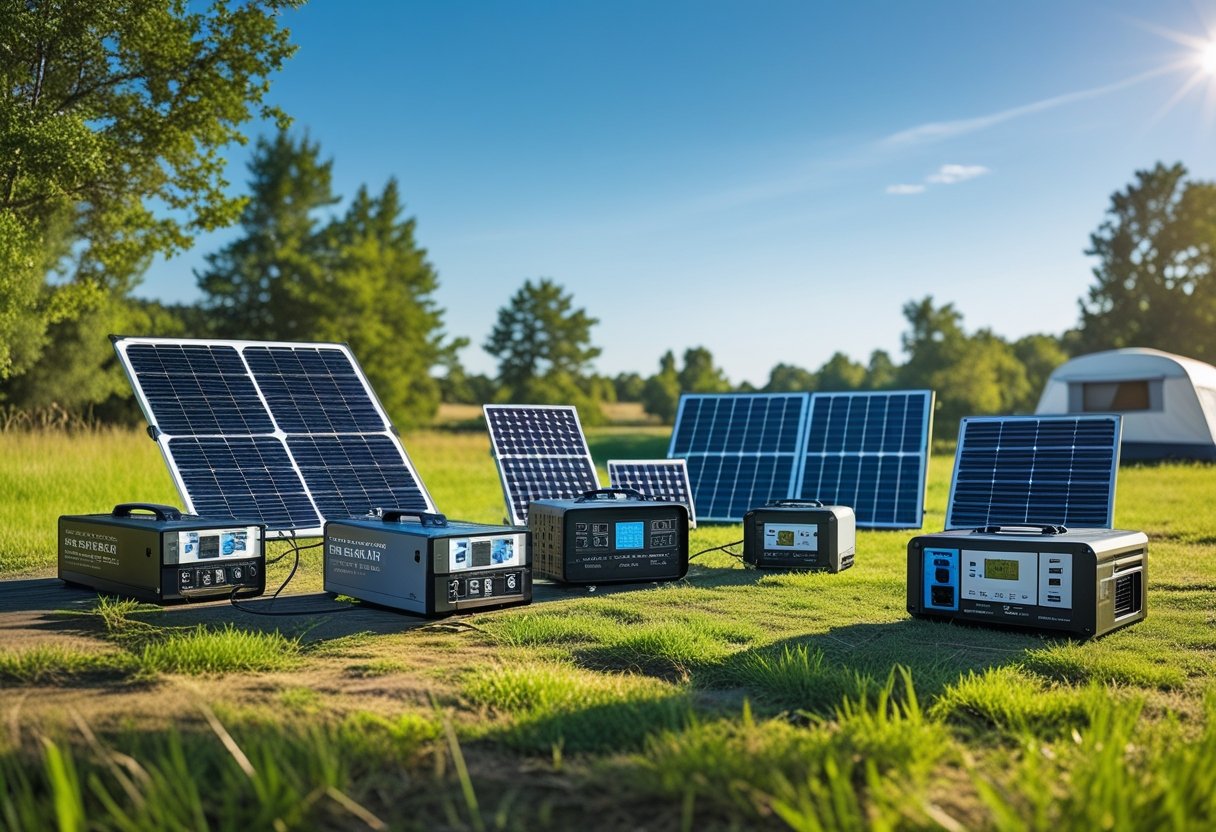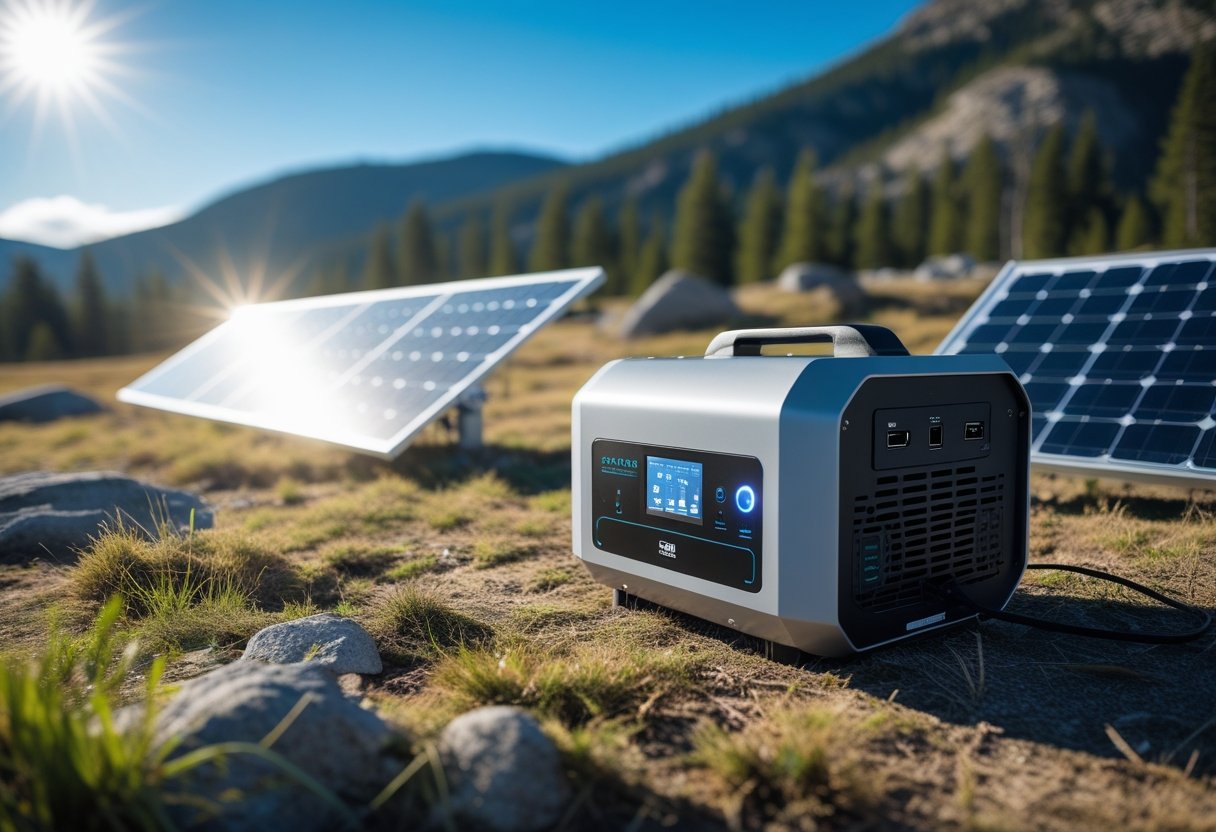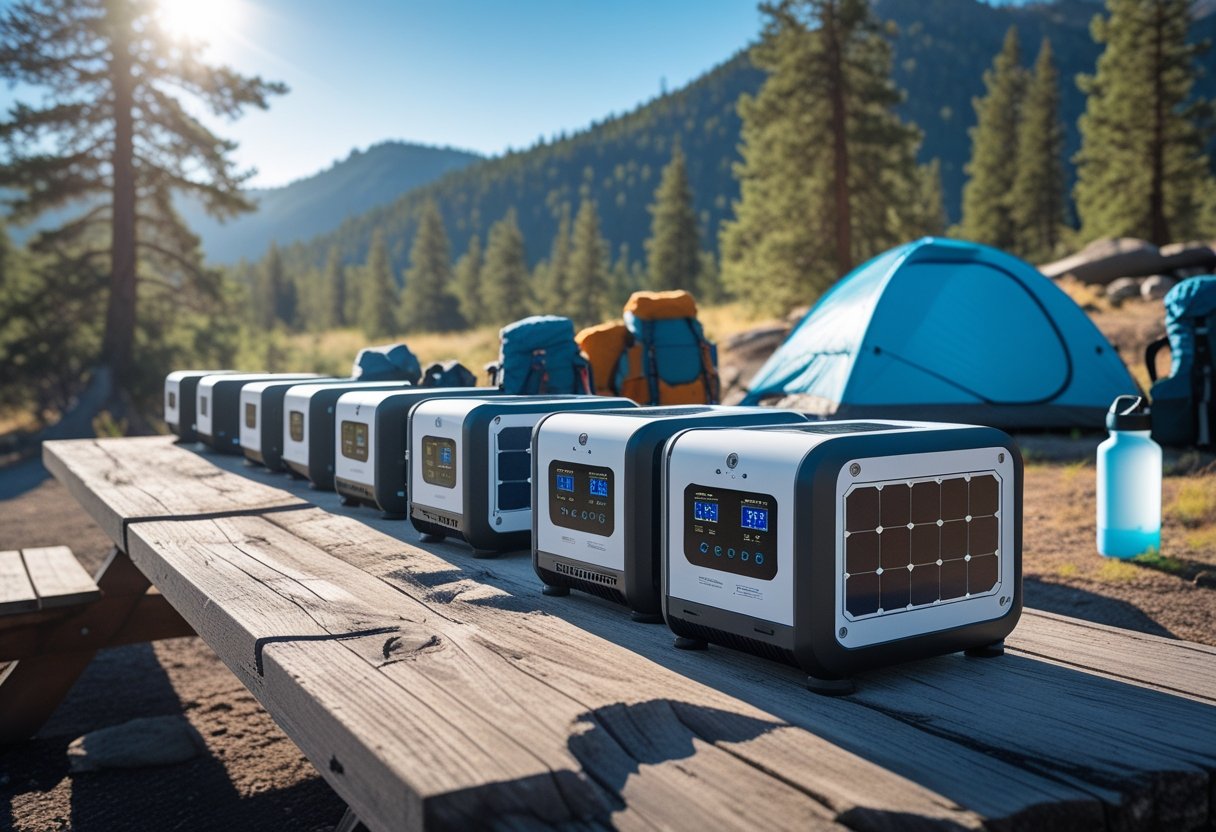Living off-grid demands reliable, portable power solutions that can handle various energy needs without access to traditional electricity. Solar generators have become essential for off-grid living because they convert sunlight into usable power, providing a clean and quiet energy source. The best solar generators for off-grid living balance capacity, portability, and durability to ensure consistent power in remote locations.

Choosing the right solar generator means evaluating models that offer enough power for essential devices, efficient solar panel compatibility, and ease of transport. Brands like Jackery, EcoFlow, and Bluetti are popular for their dependable performance and range of options tailored to off-grid lifestyles. This guide highlights the top solar generators that meet these criteria, helping readers find the right fit for their unique energy needs.
For those living without grid access, investing in a solar generator that delivers steady, renewable energy can significantly improve quality of life and independence. Understanding the capabilities and features of the best models makes it easier to select a unit that supports everything from basic lighting to powering larger appliances. Explore the leading options designed specifically for off-grid power supply needs.
Key Features of Solar Generators for Off-Grid Living

Solar generators designed for off-grid use must deliver reliable power while being efficient in energy management and easy to transport. Critical elements include the ability to store sufficient energy, convert it effectively, and recharge quickly using solar panels. Attention to design and technology ensures users can count on their generator in remote locations.
Battery Capacity and Power Output
Battery capacity determines how long a solar generator can supply power without recharging. It is measured in watt-hours (Wh) and directly impacts the length of time devices and appliances can run. Off-grid users should consider generators with at least 1,000 Wh capacity for extended use, such as the Goal Zero Yeti 3000X with a 3 kWh capacity suitable for higher power demands.
Power output, measured in watts (W), defines the amount of energy the generator can deliver at once. For typical off-grid needs, a continuous inverter wattage of 1,000 to 2,000 W covers small appliances, lights, and charging electronics. Higher surge wattage helps start motor-driven devices like refrigerators or power tools. Selecting a model with an inverter matching the total power requirement ensures safe, steady operation.
Portability and Compact Design
Portability is vital for users who need to move their generator between campsites or remote locations. Lightweight and compact design reduce the burden of transport while allowing flexible placement. Many solar generators weigh between 20 and 60 pounds, balancing battery capacity with ease of handling.
Compact design often includes integrated handles and durable casing, benefiting those living or traveling off-grid. Some models offer stackable or modular batteries, enabling users to adjust capacity without adding excessive bulk. Portability should not compromise battery size but should optimize space and weight for the user’s typical energy usage and mobility needs.
Inverter Technology and Charge Controllers
The inverter converts stored DC battery power into AC power for household devices. Pure sine wave inverters are preferred as they provide clean, stable electricity compatible with sensitive electronics, reducing the risk of damage. Off-grid solar generators typically feature inverters with high efficiency to maximize usable power.
Charge controllers regulate the flow of energy from solar panels to the battery, preventing overcharging and extending battery life. MPPT (Maximum Power Point Tracking) controllers are more efficient than PWM variants, optimizing solar input under varying conditions. Effective inverter and charge controller technology work in tandem to improve reliability and protect the system.
Solar Charging Compatibility
Compatibility with solar panels is a critical feature enabling off-grid sustainability. The solar generator should support a high maximum solar input wattage to reduce recharge times, with top models handling 1,000 watts or more. Fast solar input rates help replenish the battery even in less-than-ideal sunlight.
Users need to confirm the generator’s input voltage and connector types to ensure seamless connection to chosen solar panels. Many units support daisy chaining of panels, allowing expansion of solar array size as energy needs grow. Efficient solar charging capability directly influences overall autonomy and reduces dependence on alternative power sources.
Learn more about selecting generators optimized for off-grid living at OUPES.
Top Solar Generator Products for Off-Grid Living

Strong battery capacity, versatile charging options, and reliable build quality are critical for off-grid solar generators. Portability and expandability also rank highly since users vary in power needs—from small appliances to whole-home backup. Multiple brands deliver distinct advantages in these areas.
EcoFlow and BLUETTI Models
EcoFlow and BLUETTI are well-regarded for their high-capacity, fast-charging portable power stations. EcoFlow’s Delta series offers up to 3600W surge power with multiple ports, including USB-C, making it useful for charging modern devices quickly.
BLUETTI combines large battery storage—often around 3000Wh—with durable inverter technology. Models like the BLUETTI AC200P provide stable power output and support for expandable solar input. Both brands focus on user-friendly interfaces and app control for monitoring.
Their products balance portability with power, making them suitable for extended off-grid use or emergency home backup.
Jackery and Goal Zero Solutions
Jackery is known for its lightweight, durable power stations like the Explorer 2000 Plus. It emphasizes ease of use with solar panels that are foldable and efficient. Jackery’s generators prioritize quick recharge through both solar and wall outlets.
Goal Zero offers robust portable solar solutions like the Yeti 500X. These feature various charging methods and rugged designs adapted for outdoor settings. Goal Zero excels in combining moderate power capacity with portability, ideal for camping or short-term off-grid use.
Both companies provide seamless integration of solar charging to minimize reliance on grid power.
Renogy, Generac, and Victron Options
Renogy focuses on complete solar kits, pairing generators with solar panels and charge controllers. Their power stations serve users needing modular, scalable off-grid setups. Renogy’s products fit well in situations where users plan to build or expand a solar system.
Generac, traditionally a standby generator manufacturer, has entered the solar generator market with hybrid solutions that blend solar power with fuel options. This approach suits users wanting solar benefits but with backup reliability when sunlight is limited.
Victron specializes in power electronics and offers solar generators known for professional-grade battery management and system integration. Victron products often target users requiring advanced customization and long-term off-grid installations.
Budget-Friendly and Amazon Picks
Affordable options for solar generators exist, particularly through popular Amazon listings. These may have lower capacity—often under 1000Wh—and fewer features but can support basic power needs like charging phones and running small appliances.
Budget models usually provide simple portability and are suited for casual campers or as emergency backup. Brands here vary widely, and product reviews and ratings on Amazon help gauge reliability and customer satisfaction.
Consumers prioritizing low cost should carefully assess battery lifespan and solar panel compatibility before purchase.
Essential Uses and Off-Grid Applications
Solar generators serve multiple practical purposes, especially where regular electricity access is limited or unreliable. They provide reliable energy for essential devices, support outdoor activities, and maintain critical household functions without fossil fuels.
Backup Power During an Outage
Solar generators are crucial for emergency backup power, keeping essential electronics and devices operational during power outages. They can run communication tools, lights, and medical equipment, which is especially important in severe weather events or extended blackouts.
Battery capacity and inverter size determine how long and what devices a solar generator can support. Models with larger batteries and higher output inverters provide longer runtime and can handle heavier loads, such as sump pumps or multiple appliances.
Selecting a solar generator designed for backup power ensures smooth functionality during emergencies, reducing dependency on noisy and fuel-consuming gas generators. Users benefit from quieter, cleaner energy that requires little maintenance.
Solar Generators for Camping and Travel
For camping trips, solar generators provide silent, renewable power for lighting, phone charging, and small electronics. They eliminate the need for fuel, making them ideal for long stays in remote locations.
Portability and ease of setup are key factors for a solar generator for camping. Lightweight models with foldable panels enhance mobility and faster deployment at campsites.
Solar generators also support off-grid applications like powering electric coolers, fans, and even small heaters. Reliable energy access improves comfort, safety, and convenience on outdoor excursions.
Powering Small Appliances and Fridges
Small appliances and fridges require consistent power, which solar generators can provide if appropriately sized. Energy needs for these devices vary but typically demand stable inverter output and sufficient battery storage.
Users must calculate appliance wattage and daily usage to choose a solar generator with adequate battery capacity. For example, a fridge might need a generator capable of supplying at least 100-300 watts continuously.
Solar generators designed for off-grid living often include features like pure sine wave inverters to protect sensitive appliances. This capability allows for safe operation of refrigerators and other small devices critical to food storage and daily living.
More details on sizing and options are available in the complete guide to selecting the best solar generator.
Buying Guide and Maintenance Tips
Choosing the right solar generator involves balancing upfront costs, efficiency, and long-term usability. Maintenance demands, potential customization, and battery technology also heavily influence the overall value and performance in off-grid scenarios.
Cost-Effective Buying Strategies
When selecting a solar generator, buyers should focus on systems that match their exact power needs to avoid overspending on unnecessary capacity. Comparing units based on watt-hour (Wh) ratings and power output (watts) helps identify the right size.
Purchasing during sales or through discounts can reduce initial costs significantly. Considering budget models with good reviews and essential features is wise before investing in premium units. It’s important to factor in potential extra costs, such as additional solar panels or accessories, to maintain cost-effectiveness.
Brands offering upgradeable battery packs, such as UPG systems, allow users to start small and expand capacity later. This flexibility can optimize initial spending while accommodating future power demands.
Minimal Maintenance Requirements
Modern solar generators require little upkeep compared to fuel-based models. Users mainly need to ensure solar panels are clean and free from debris to maintain optimal charging efficiency.
Battery health monitoring is critical, particularly with lithium battery types. However, LiFePO4 batteries used in many newer models reduce maintenance by offering longer lifespans and stable chemical properties.
Routine inspections of cables and outlet connections help avoid performance issues. Storing the generator in dry, temperature-controlled environments further extends its life and reliability with minimal effort.
DIY and Customization Options
Some solar generators support DIY expansions for users with technical skills. Adding extra solar panels or upgrading battery modules is common to increase capacity and running time.
Open-platform systems or those compatible with popular battery types like LiFePO4 make customization easier and safer. These options let users tailor their power setups based on evolving energy needs.
Users should carefully review manufacturer guidelines when performing upgrades or DIY builds to avoid voiding warranties. Clear, modular designs encourage safe user modifications without requiring full technical expertise.
Renewable Energy Benefits and LiFePO4 Batteries
Solar generators leverage renewable energy to provide clean, silent power without fossil fuels. This reduces environmental impact in off-grid living and emergency situations.
LiFePO4 batteries are a key technology in renewable energy storage thanks to their stability, safety, and long cycle life, often exceeding 2,000 charge cycles. They are less prone to overheating or capacity loss compared to traditional lithium-ion batteries.
Using LiFePO4 technology enhances system reliability and reduces the total cost of ownership by minimizing battery replacements. These batteries also charge faster and discharge more efficiently, making them ideal for sustainable off-grid power solutions.
For more detailed guidance on selecting solar generators, see the Ultimate Solar Generator Buyer’s Guide 2024.
Top Pick: Jackery Explorer 1000
Reliable, portable, and powerful — ideal for blackouts, camping, and off-grid living.
Check Price on Amazon →